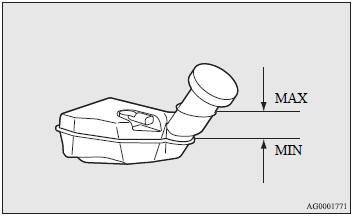Mitsubishi Outlander: Brake fluid/Clutch fluid
The brake fluid and the clutch fluid share reservoir tank.
To check the fluid level

The fluid level must be between the ŌĆ£MAXŌĆØ and ŌĆ£MINŌĆØ marks on the reservoir.
The fluid level is monitored by a float. When the fluid level falls below the ŌĆ£MINŌĆØ mark, the brake fluid warning lamp lights up.
The fluid level falls slightly with wear of the brake pads, but this does not indicate any abnormality.
The fluid in the master cylinder should be checked when doing other work under the bonnet. The brake system should also be checked for leaks at the same time.
If the fluid level falls markedly in a short length of time, it indicates leaks from the brake system.
If this occurs, we recommend you to have the vehicle checked.
Recommended fluid
Use brake fluid conforming to DOT3 or DOT4. The brake fluid is hygroscopic. Too much moisture in the brake fluid will adversely affect the brake system and clutch system, reducing the performance.
The brake fluid reservoir uses a special cap to prevent air from entering the reservoir. Do not remove the cap.
CAUTION:
● Take care in handling brake fluid as it is harmful to the eyes, may irritate your skin and also damage to painted surfaces.
● Use only the specified brake fluid.
Also, the additives in different brands may result in a chemical reaction when mixed together, so avoid mixing different brands.
● Normally, keep the reservoir tank cap closed to prevent the brake fluid from deteriorating.

